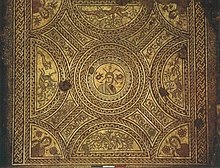This article needs additional citations for verification. (September 2018) |
| The Hinton St Mary Mosaic | |
|---|---|
 | |
| Material | Ceramic |
| Created | early 4th century |
| Period/culture | Romano-British (Christian) |
| Place | Hinton St Mary villa, Dorset |
| Present location | G49/wall, British Museum, London |
| Registration | 1965,0409.1 |
The Hinton St Mary Mosaic is a large, almost complete Roman mosaic discovered at Hinton St Mary, Dorset, England in 1963. It appears to feature a portrait bust of Jesus Christ as its central motif, which could be the oldest depiction of Jesus Christ anywhere in the Roman Empire.[1] A second mosaic was found during 2022 excavations on the site.[2] The mosaic was chosen as Object 44 in the BBC Radio 4 programme A History of the World in 100 Objects, presented by British Museum director Neil MacGregor.
The mosaic has two wings in its north-east angle set at about a right angle. The room is 8.5 m (28 ft) by 6 m (20 ft), connected to the east-west long axis.[3] The mosaic covered two rooms, joined by a small decorated threshold. It is largely red, yellow and cream in colouring. On stylistic grounds it has been dated to the 4th century and is attributed to the mosaic workshop of Durnovaria (modern Dorchester). It is currently in storage at the British Museum, although the central medallion is on display there.
- ^ "THE ROMAN VILLA AT HINTON ST MARY". Vianova Archaeology. Retrieved 6 December 2022.
- ^ "Second mosaic at Hinton St Mary leads to a history re-write". The Blackmore Vale, 2 July 2022. 2 July 2022. Retrieved 6 December 2022.
- ^ Pearce, Susan (2008). "The Hinton St Mary Mosaic Pavement: Christ or Emperor?". Britannia. 39: 4 – via JSTOR.